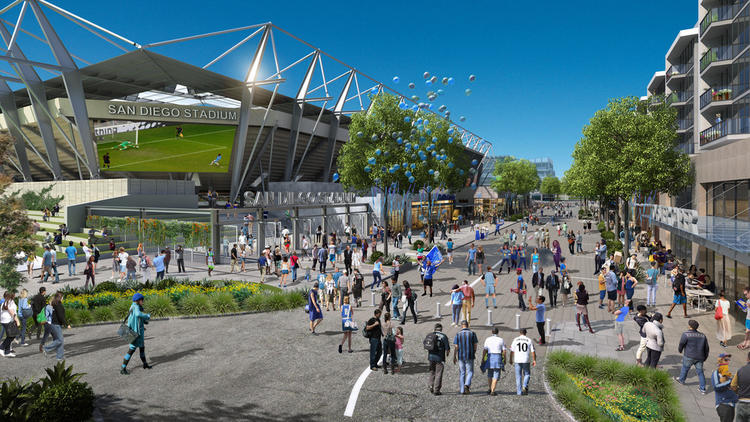Despite the hype it has received, the proposed SoccerCity development in San Diego still does not have the firm backing of San Diego State University.
As part of an effort to redevelop the Qualcomm Stadium site in Mission Valley, FS Investors has proposed a mixed-use development that would include a stadium (shown in the rendering above) for an MLS expansion franchise. SoccerCity, which was covered recently on our sister site, Soccer Stadium Digest, would include a stadium along with 4,800 homes, two hotels, and 800 student apartments. In addition, 16 acres would be set aside for a five-year period to construct a new NFL stadium if a team returns to San Diego.
That proposal has turned heads as it relates to MLS expansion, but for now SoccerCity does not have a commitment from SDSU. In a recent statement, SDSU stressed that it is still exploring its options in Mission Valley, where it could build a new stadium as part of a campus expansion.
One of the major questions has been whether SDSU would partner with FS Investors on the stadium, which would lead it to being used for Aztecs football along with the MLS. Thus far, SDSU officials, including athletic director John David Wicker, have been noncommittal about the plan. As Mark Zeigler at the San Diego Union-Tribune explains, SDSU’s trepidation might be based in cost concerns:
The proposed 30,000-seat stadium is indeed expandable to 40,000, just like FS Investors says, just like you could add a second story to your house. But at what price? Wicker is concerned that the stadium’s surrounding density is such that any such expansion — a necessity if SDSU hopes to one day catch the eye of a power conference and its television riches — would be “cost prohibitive.”
As Wicker understands the fine print, the university would be on the hook for environmental impact reports and permitting, along with parking and traffic mitigation for the additional influx of cars; the cost could top $100 million alone. It also might require the blessing of MLS, which has made it clear on numerous occasions that it wants franchises playing in stadiums half that size.
And that’s before tearing the roof off the original stadium and building up, because planned structures abutting the end zone prevent any expansion in that direction.
There are other issues involving the ownership of the land and control of revenue streams, critical for an athletic department that annually struggles to balance its budget despite huge public subsidies.
SDSU’s $100 million contribution to the stadium would be financed through fund-raising but mostly — maybe $75 million or more — through bonds. It could mean debt amounting to, say, $4 million per year that would be repaid largely with increased revenues from the new stadium not currently available at Qualcomm, a perilous proposition if terms aren’t optimal.
SDSU has several issues to contemplate over the next few years. Aside from the campus expansion, the school will have to make a decision on where its football team will play over the long run. The Aztecs are set to use Qualcomm Stadium for at least the next two years, but could leave the facility after the 2018 season if the decision is made to tear down the facility.
RELATED STORIES: SDSU Engaging With Developers on Qualcomm Stadium Site; San Diego Mulling Qualcomm Stadium’s Future

